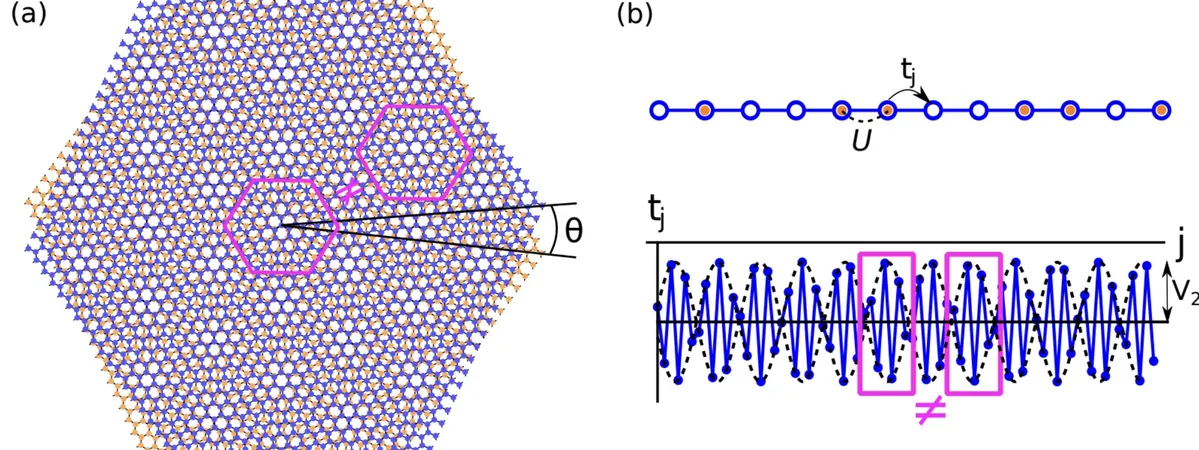
Revolutionary Study Reveals New States of Matter in 1D Moiré Systems – What They Found Will Blow Your Mind!
2024-11-07
Author: Jia
Groundbreaking Discoveries in Condensed Matter Physics
Researchers from the prestigious Universidade de Lisboa, Universidade do Porto, and Universidade do Minho have achieved a groundbreaking discovery in the field of condensed matter physics. Their recent study, published in *Nature Physics*, unveils how the unique structural properties of moiré materials, particularly stark transformations due to quasiperiodicity, can significantly alter their ground-state properties.
Understanding Moiré Materials
Moiré materials, renowned for their special optical and electronic characteristics, are formed by stacking two or more layers of 2D materials with minor lattice mismatches. This slight deviation generates a striking pattern known as the moiré pattern, which can be manipulated by adjusting the twist angle between layers, allowing scientists to explore various electronic phases, including fascinating states like superconductivity.
Ambitious Aims of the Research
Miguel Gonçalves, the lead author of the study, expressed the ambitious aims driving this research: “We sought to unravel how the interplay between quasiperiodicity and electron-electron interactions could lead to new states of matter not achievable in traditional periodic systems.” He emphasized the significant attention these materials have garnered within the physics community over the past six years due to their exotic phases of matter that challenge existing theories.
Challenging Traditional Theories
Traditionally, most theoretical examinations of moiré systems have assumed periodicity—where atoms are arranged in a uniform pattern. But Gonçalves’ team dared to go beyond this assumption, investigating how quasiperiodicity—a spatial pattern that gradually varies rather than neatly repeating—could impact quantum behavior. Their exploration revealed that when they delved deeper into the role of quasiperiodicity, they encountered entirely new phenomena that can arise only in these non-periodic arrangements.
Innovative Simulation Techniques
By utilizing an advanced technique known as the density-matrix-renormalization-group method, the researchers successfully simulated the dynamics of electron interactions across a one-dimensional (1D) atomic chain exhibiting quasiperiodic hopping between atoms. Their model shares critical features with the two-dimensional moiré systems observed in experimental settings.
Stunning Discoveries
To their astonishment, the results showcased that as the hopping strength reached a critical threshold, the 1D quasiperiodic moiré system entered a multifractal phase, completely alien to periodic systems. Remarkably, when interactions were introduced, the team identified a novel regime dubbed "quasi-fractal charge density wave," characterized by intricate modulations in the charge order with an unexpected amplitude of wave vectors.
Implications of the Research
The implications of this discovery are immense. It suggests the possibility of realizing new states of matter that had long been theorized but never encountered in less complex periodic systems. The team also acknowledged the potential for lab experiments using ultracold atoms to validate their findings—setting the stage for exciting advancements in physics and materials science.
Future Research and Excitement
Gonçalves concluded on a hopeful note, revealing future plans to explore the nuances of quasiperiodicity in two-dimensional moiré materials. “We’re excited to uncover a richer array of exotic states that could redefine our understanding of quantum materials,” he stated, hinting at the bright future ahead in this electrifying field of research.
A New Era in Physics
Stay tuned, as the world of physics stands on the brink of new revelations that could change everything we know about materials and their properties!


 Brasil (PT)
Brasil (PT)
 Canada (EN)
Canada (EN)
 Chile (ES)
Chile (ES)
 España (ES)
España (ES)
 France (FR)
France (FR)
 Hong Kong (EN)
Hong Kong (EN)
 Italia (IT)
Italia (IT)
 日本 (JA)
日本 (JA)
 Magyarország (HU)
Magyarország (HU)
 Norge (NO)
Norge (NO)
 Polska (PL)
Polska (PL)
 Schweiz (DE)
Schweiz (DE)
 Singapore (EN)
Singapore (EN)
 Sverige (SV)
Sverige (SV)
 Suomi (FI)
Suomi (FI)
 Türkiye (TR)
Türkiye (TR)